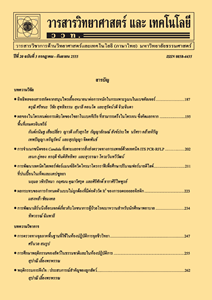การประยุกต์ภูมิสารสนเทศเพื่อหาพื้นที่ศักยภาพในการอพยพและเส้นทางลำเลียงเคลื่อนย้าย : กรณีศึกษาการเกิดอุทกภัยจังหวัดปทุมธานี
Main Article Content
Abstract
บทคัดย่อ
งานวิจัยนี้มีวัตถุประสงค์เพื่อหาพื้นที่ศักยภาพในการอพยพผู้ประสบอุทกภัย ศักยภาพในการรองรับ และเส้นทางลำเลียงเคลื่อนย้ายที่เหมาะสมสำหรับการอพยพ โดยประยุกต์ภูมิสารสนเทศร่วมกับการวิเคราะห์ตัดสินใจแบบพหุเกณฑ์ด้วยวิธีการถ่วงน้ำหนักอย่างง่าย โดยใช้ 5 ปัจจัย ดังนี้ (1) ขอบเขตอุทกภัย (2) เส้นทางคมนาคม (3) ความลาดชัน (4) ความสูงภูมิประเทศ และ (5) การใช้ประโยชน์ที่ดิน สำหรับการวิเคราะห์เส้นทางลำเลียงได้ใช้วิธีการวิเคราะห์โครงข่ายคมนาคมโดยพิจารณาเส้นทางที่สั้นที่สุดจากศูนย์รออพยพไปยังศูนย์บรรเทาพิบัติภัย ผลการศึกษาพบว่าพื้นที่มีศักยภาพจำนวนทั้งสิ้น 284 แห่ง รวม 105,045 ไร่ อยู่ในกรุงเทพมหานคร 80 แห่ง (พื้นที่ 44,929 ไร่) ปราจีนบุรี 66 แห่ง (พื้นที่ 21,036 ไร่) นครปฐม 46 แห่ง (พื้นที่ 14,218 ไร่) สมุทรปราการ 31 แห่ง (พื้นที่ 9,409 ไร่) ฉะเชิงเทรา 17 แห่ง (พื้นที่ 5,724 ไร่) สระบุรี 17 แห่ง (พื้นที่ 3,473 ไร่) สมุทรสาคร 12 แห่ง (พื้นที่ 1,944 ไร่) สุพรรณบุรี 8 แห่ง (พื้นที่ 2,552 ไร่) และนครนายก 7 แห่ง (พื้นที่ 1,756 ไร่) มีศักยภาพในการรองรับผู้ประสบอุทกภัยได้ทั้งสิ้น 3,734,948 คน ผลการศึกษาเส้นทางลำเลียงเคลื่อนย้ายพบว่ามีทั้งหมด 34 เส้นทาง จากศูนย์รออพยพไปยังศูนย์บรรเทาพิบัติภัย สำหรับเส้นทางที่สั้นที่สุดคือจากมหาวิทยาลัยรังสิตไปยังโรงเรียนพณิชยการสามเสน กรุงเทพมหานคร โดยมีระยะทาง 24.85 กิโลเมตร ใช้เวลาประมาณ 25 นาที ในทางกลับกันเส้นทางที่ยาวที่สุดคือเส้นทางจากโรงเรียนแสนชื่นปานนุกูลไปยังโรงเรียนบ้านโคกพนมดี ปราจีนบุรี โดยมีระยะทาง 98.09 กิโลเมตร ใช้เวลาประมาณ 1 ชั่วโมง 38 นาที งานวิจัยนี้เป็นเพียงการวิเคราะห์ทางกายภาพ ยังไม่ได้มีการวิเคราะห์ในมิติเชิงสังคม เช่น การประเมินมูลค่าความเสียหาย ความแตกต่างในการอพยพ จึงเป็นแนวทางที่จะนำมาวิเคราะห์ในงานวิจัยในอนาคตต่อไป
คำสำคัญ : ระบบภูมิสารสนเทศ; พื้นที่ศักยภาพ; เส้นทางลำเลียง; อุทกภัยจังหวัดปทุมธานี
Abstract
The Objective of this research is to analyze and identify the potential areas for flood evacuation, the potential support and the suitable evacuation route by using an application of geo-informatics for multi criteria decision analysis (MCDA) base on simple additive weighting (SAW) of 5 factors as follow: (1) flood areas, (2) routes, (3) slope, (4) elevation and (5) land use. For the analysis of evacuate route using network analysis by considering the shortest transport route from evacuate tansfer center (ETC) to disaster relief center (DRC). In summary there are 284 potential areas equal to 105,045 rai consist of Bangkok 80 areas 44,929 rai, Prachin Buri 66 areas 21,036 rai, Nakhon Pathom 46 areas 14,218 rai, Samut Prakan 31 areas 9,409 rai, Chachoengsao 17 areas 5,724 rai, Saraburi 17 areas 3,473 rai, Samut Sakhon 12 areas 1,944 rai, Suphan Buri 8 areas 2,552 rai and Nakhon Nayok 7 areas 1,756 rai. Total victims supports are 3,734,948 victims. The research inform that there are 34 routes for evacuate from evacuate transfer center (ETC) to disaster relief center (DRC). The shortest route from Rangsit University to Samsen Commercial School, Bangkok which distance is 24.85 kilometers in 25 minutes and the longest route from Saen Cheun Pannukul School, Prachin Buri which distance is 98.09 kilometers in 1 hour and 38 minutes. This research is physical analysis only, exclude the social analysis such as the damage cost evacuation and difference of evacuate. Therefore it's an approach that will be analyzed in future research.
Keywords: geo-informatic; potential area; transport router network; flood Pathum Thani


